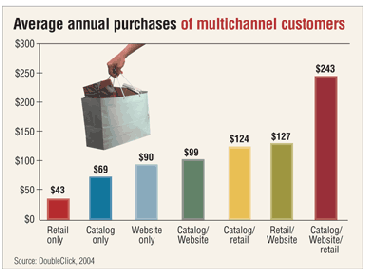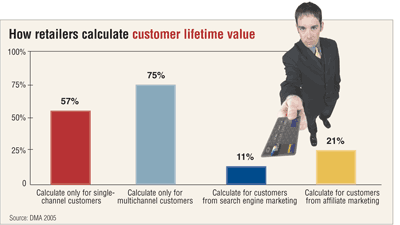Multichannel Merchant welcomes a new columnist to the fold: Love Goel, chairman/CEO of Growth Ventures Group, a multichannel retail investment firm based in Minnetonka, MN. A former chief operating officer for Federated Department Stores and Fingerhut, Goel will be writing about multichannel, customer-centric marketing, or as his company has dubbed it, mc3.
It is alarming to realize that most top retail executives and board members are clueless about how to create, build, lead, and integrate a multichannel, customer-centric organization. The gap between rhetoric and reality at most retailers is quite astounding. Here are the seven most common examples of leadership failure that we observe:
- FEAR OF THE UNKNOWN
Some retailers suffer from an “ostrich” complex in that they like to hide their heads in the sand pretending that the Internet doesn’t exist or that two out of three of their store or catalog shoppers don’t research products online before buying offline. They think the Internet is just another channel or a passing fad that they can live without. If you’re guilty of this thinking, here are four distinctions regarding the Web to keep in mind:
a) A Website is available to anyone — not only people who receive your catalogs or who drive to your stores — anywhere, 24/7.
b) The Internet enables you to truly personalize an offer (product, price point, promotion) in real-time based on the latest available data about your business — say, inventory status — and more important, about your customer.
c) Americans spend more time using the Internet than they do engaged in any other medium, including TV, newspapers, magazines, and radio.
d) When used correctly, the Internet is a cheaper customer acquisition, transaction, and service platform than is a store or a print catalog.
Here’s one more data point of note: Multichannel customers are worth at least four times — and sometimes even eight or 10 times — as much as single-channel customers.
We advise retailers such as TJX and Kohl’s to quickly figure out how to make this transition before it is too late and they are left holding the bag. The same advice goes to merchants that believe they can let someone else, such as Amazon.com, run one of their channels. But kudos to one-time Web-only merchants who realized that they can benefit by mailing print catalogs and perhaps opening a store or two as well.
We do not believe that the Internet will replace the store, the catalog, or other means of commerce. But it will continue to play an increasingly important role in how people learn about products and services, how and where they shop, and how they communicate. That’s why you need to embrace it wholeheartedly and integrate it within your core business, rather than make it a silo run by a dispensable executive.
-

- SHORTAGE OF TALENT
Too many senior executives and corporate boards fail to heed the adage “a business is only as good as the people running it.” For an mc3 merchant, having expertise across channels and functions is crucial for dealing with each medium’s unique challenges and opportunities.
Many businesses, for instance, have a chief information officer or an IT executive lead their Web effort. That’s akin to having a facilities executive in charge of the retail business. Likewise, a merchandiser who knows how to put together the right assortment of product for a store may have no idea how to do the same for a print catalog or a Website.
The quality and composition of executive teams makes you wonder about the caliber of the board of directors at many of these places and whether the search firms advising them are ignorant or just plain greedy. The retail industry is not known for grooming the next generation of leaders and executives.
As an aside, if you don’t have a 20-something on your Internet management team, you are probably missing the boat.
- FOGGY VISION
To be successful in creating a mc3 retailer, you must articulate and define what success means. Many companies pursue multichannel, customer-centric strategies because they know they must but have no clear plan of where exactly they are headed.
Success needs to be defined within three areas: strategic, operational, and financial. For strategic success, you need to understand and articulate how initiatives will benefit four key constituencies: the customer, the company (and its employees), the investors (or shareholders), and the vendors and other business partners. From an operating and financial perspective, you must understand how initiatives will change your three most important platforms — customer acquisition, transaction, and service — to drive a superior experience for customers and higher growth and margins for the business.
That said, a company can also leverage these multiple channels to improve its own internal level of service and communications with its employees, shareholders, business partners, and vendors. All of the above should be very thoughtfully aligned to deliver powerful and measurable financial and operating metrics along with customer loyalty and lifetime value.
- LACK OF CHANNEL UNDERSTANDING
It is not uncommon to walk into a board meeting and hear someone say, “Ohmigod, business is hot — our traffic is shooting through the roof!” Now if traffic to a brick-and-mortar store were soaring, this would be fabulous indeed. In a store environment, traffic is a very good indicator of sales because conversion rates are high. Once a shopper has made the decision to drive to your store, navigate traffic, find a parking spot, and then walk your aisles and look for product on your shelves, he is fairly unlikely to leave without making a purchase, even if what he finds isn’t exactly what he wants, because he doesn’t want to have to repeat the driving/navigating/parking/walking process.
But if the traffic in question is Website traffic, the business may not necessarily be hot at all; driving traffic to a Website is not that difficult in this pay-per-click world. Driving traffic that converts into buyers — that’s another thing altogether. On the Web it’s all-too-easy to hop from one competing merchant to another; one click, one or two seconds, and you’re there.
Once you understand that, you very quickly realize you’d better have something compelling to sell people online. Your old brand and offline formula will carry you only so far, as Nordstrom and Zales discovered much to their chagrin and Zappos and Blue Nile much to their delight in selling shoes and jewelry respectively.
-

- POOR METRICS AND ACCOUNTABILITY
It is difficult to be accountable when there is lack of clarity on what and why to measure. Even today you could walk into the boardroom of most retailers, ask them which key metrics they use to track their Internet business, and receive a wide range of answers, many of which are way off the mark. The metrics that many companies track, such as Web traffic and average order sizes, can easily be manipulated by clever promotions and expensive advertising, as we mentioned above.
One of the key metrics that multichannel merchants need to focus on, and one that most direct marketers already home in on, is customer lifetime value (LTV). Without knowing customer LTV, you cannot determine how much you should pay to acquire a customer.
What many retailers that don’t calculate LTV end up doing is opting for online advertising deals that are self-funding or break even with the first transaction. As a result, they end up leaving a bunch of money on the table by not acquiring varied segments of customers, such as those who make multiple transactions but spend less per order or those who convert over a longer period of time. Surprisingly, fewer than 50% of retailers measure customer LTV, and most of those who do, do so poorly or inadequately.
-
The other metric that most retailers do not know is how much they save on an online order vs. a catalog/contact center order vs. a store order. And if you do not know that, then how do you know how much you can invest in transitioning a customer over to a lower-cost channel?
- LACK OF CONTEXT AND BENCHMARKS
I will scream the next time an established, brand-name multichannel merchant tells us how pleased it is with 15% growth in its Internet business, doubling its conversion rate to 2%, or finally having a shopping-cart abandonment rate of 55%. In a vacuum and compared with its store business, the growth rate looks phenomenal, and compared with its catalog prospecting statistics, the conversion rate is wonderful. But unfortunately those are not the correct benchmarks to track, nor are the abovementioned metrics anything to crow about.
The online retail business in the U.S. grew 25%-30% last year, so you are probably losing category market share on the Internet if you did not grow at least that much or did not see growth equal to the growth in your category, which may be even faster. And in case you think you are too big to be growing at that pace, you might not be aware that Wal-Mart, Best Buy, QVC, and Williams-Sonoma grew their Internet businesses, all of which are in the $1 billion ballpark, much more than 30%. At established brand-name multichannel merchants, Internet operations with annual sales of no more than $100 million should be growing at triple-digit rates at the very least, and Web operations with sales of more than $100 million should be growing in double digits beyond the average growth rate for the sector, in order to be winning meaningful market share.
For established brand-name merchants, Internet visitor-to-customer conversion rates should be 5% plus an adjustment upward or downward based on category, price points, and competition. For example, QVC is estimated to have a conversion rate of roughly 6%, L.L. Bean 8%, and Williams-Sonoma 10%.
The average shopping-cart abandonment rate for retailers is about 43%. So there’d better be a very good explanation if your rate is higher than that. If you are an above-average retailer with customer-friendly messaging, flow, and navigation on your site, you should see cart abandonment rates in the teens and 20s.
-

- INADEQUATE INFRASTRUCTURE
Good news: The additional capital investment required to support a robust multichannel, customer-centric infrastructure is probably less than the cost of opening a couple of stores or launching a couple of catalog titles — and the ROI is much higher, and the payback much faster, occuring in months and not years.
It is important, though, to understand the strategic objective of this mc3 infrastructure: to create a seamless platform to acquire, sell to, and service your customers regardless of channel. That means having a common customer view across channels — using a common customer profile to entice buyers to come back and make another purchase; to personalize a relevant offer whether it is at the store point of sale, the catalog contact center, or the Website; and to provide cross-channel customer service regarding everything from returns to questions about how to clean the product. It also means having a common view of your inventory and its real-time availability across channels so that customers can buy what they want, wherever they want, whenever they want with a clear expectation of when they will receive the item. In the short run, having a cross-channel view of customer data and company inventory will pay off by boosting customer satisfaction and loyalty. In the long run, it will create a barrier to entry for your competition because you have conditioned the customer to believe that you are the first place to shop within your category.
Most multichannel merchants are making progress. But the progress is neither fast enough nor good enough. Leadership, or the lack thereof, is the primary reason for this lackluster progress. Changing or bolstering leadership is a first and necessary step to becoming a world-class mc3 merchant.
